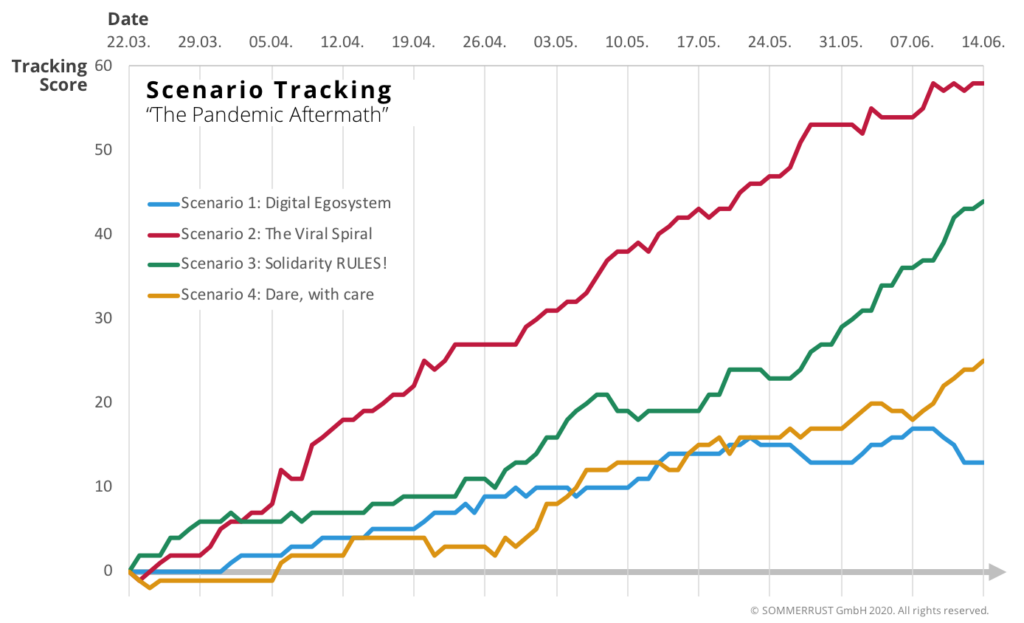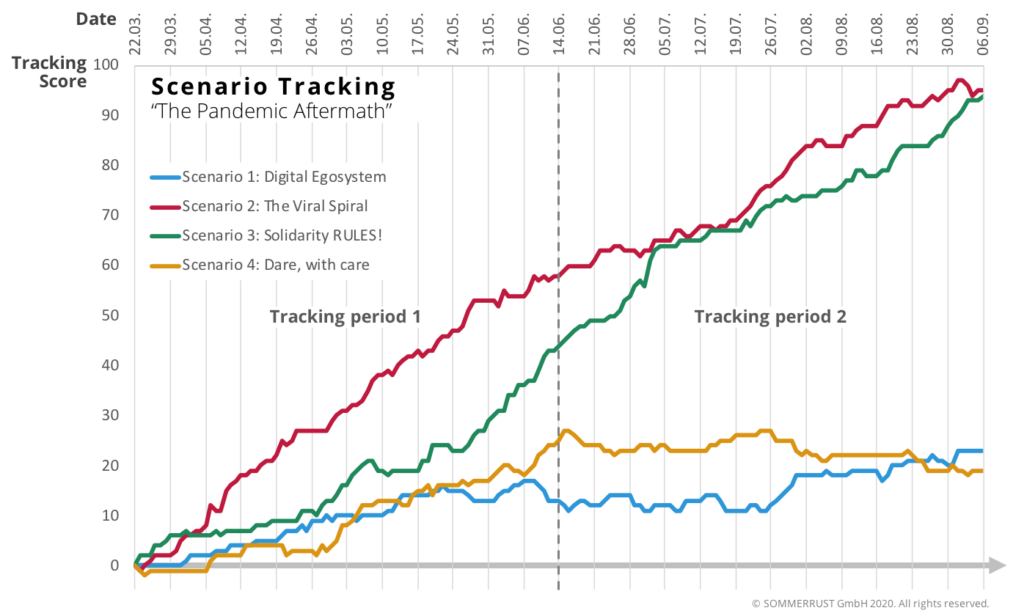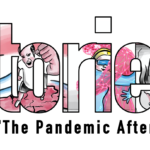In late March 2020, we created four scenarios for the year 2030 to imagine possible futures for the world after coronavirus (learn more). Shortly after, we started conducting numerous workshops to discuss and enrich the scenarios together with representatives from various industries. The scenarios were designed to provide a reference point during times of uncertainty and disorientation. We were eager to find out whether the scenarios could indeed provide an insightful lens for industries as diverse as retail, mobility or news & media. Fortunately, the feedback was very reassuring. Yet there was one question that had already been asked during our first workshop on healthcare and that we knew would be tricky to answer: “How will we know which of the scenarios will actually happen?” This question actually points to a much larger challenge, inherent to all scenario exercises: It is generally not possible to determine the probability of a specific scenario 10 years in advance. Yet what we can do is to systematically track the signals that we expect to see as a scenario comes into existence. In the following, I explain our approach to scenario tracking. It allows detecting shifts in trajectories early on and therefore increases the available room to maneuver.
The early signals are out there – but we have to capture and classify them
The basic idea we used is simple: scan the news, and if a news report fits a scenario then add one point to its tracking score. We started counting on Monday, March 23, 2020 – the day we began working on the scenarios. At this point, we assumed all four scenarios to be equally (un)likely. We then tracked the scenarios over the course of 12 weeks until June 14. In this latest update, we added another 12 weeks of tracking. This is the result for the first tracking period:
Tracking period 1: “Trouble trumps solidarity” (March 23 to June 14, 2020)

As you can see in the graph above, Scenario 3: Solidarity RULES! was the first to take the lead. It was the time when the dire situation in Italy shocked the world and caused waves of solidarity, also in Germany. Back then Germany was still at a relatively early stage of the epidemic. The growth rate of new cases was steep, but the number of deaths was still low. Schools had already been closed and further social distancing measures took effect right at the start of our observation period – initially with overwhelming support by the population. After a couple of weeks, however, as the pandemic continued to spread in Germany and around the world, news related to a less favorable scenario started to dominate: Scenario 2: The Viral Spiral.
With the shutdown of the economy, a dramatic recession began to unfold. As described in The Viral Spiral, the political climate also started to deteriorate. In Germany, conspiracy theories began to spread. On the international stage, tensions between the U.S. and China intensified and international cooperation began to suffer as the U.S. departure from the World Health Organization (WHO) illustrates.
Although our tracking still sees scenario 2 clearly in front in mid-June, scenario 3 has gained a lot of ground during the previous weeks – not least triggered by the death of George Floyd on May 25 and the ensuing protests against racism. The initial news of gentle solidarity have now been replaced with raised fists calling for justice.
Scenario 4: Dare, with care had a slow start and is currently on third position. Public health clearly was top priority in Germany initially. It took until May that discussions about loosening restrictions got some traction and changed the trajectory of the tracking score. By now, schools are opening again and voices that question the legitimacy of the drastic limitation of civil liberties become louder.
Until now, we found the fewest signals to indicate the materialization of Scenario 1: Digital Egosystem. Although significant parts of private and work life have shifted to the online domain, the challenges of digitalization also became apparent. In the case of Germany, this is maybe best illustrated by the back-and-forth related to the much-anticipated Corona tracing app. It has not been launched during our 12-week observation period. It will be interesting to see if the app can overcome German skepticism and provide some momentum to scenario 1 now that it is available.
Tracking period 2: “Law and unorder” (June 15 to September 6)

The second tracking period is characterized by a widening gap between scenarios 2 & 3 on the one hand, and 1 & 4 on the other hand. Scenario 2: The Viral Spiral continued to climb, although more slowly than during the previous tracking period. Main drivers were radicalization, fake news and the increasingly aggressive atmosphere that included local outbreaks of violence in several German cities as well as an attempt by protesters to storm the Reichstag. Bad economic news also contributed to the rising score initially. More recently, however, signs of improvement became more frequent and may mark the beginning of an economic recovery.
Meanwhile, Scenario 3: Solidarity RULES! showed an even stronger increase in the tracking score, mainly based on a push for sustainability in various fields. For example, coronavirus outbreaks in meat processing plants triggered a larger discussion about poor working conditions and animal welfare. Moreover, acts of solidarity could be observed on different levels (e.g., financial aid for Syria or Lebanon as well as for especially affected groups in Germany). At the same time, we saw the emergence of a number of morally charged public debates, e.g. related to police brutality. Scenario 3 is now almost on a par with scenario 2 and will surpass it if the recent trajectory continues.
The biggest „loser“ of the second tracking period is Scenario 4: Dare, with care. As the only one of the four scenarios it has a lower tracking score now than 12 weeks earlier. After schools were opened again and travel restrictions were lifted, some of these measures have been taken back amid rising daily case numbers within Germany and at some travel destinations. Initially voluntary tests for people returning from vacation became mandatory for risk areas. First efforts to realize larger events are contrasted by calls for stricter regulation and enforcement regarding the obligation to wear face masks, e.g. in trains or stores. The perceived decline in discipline among the population combined with the looming threat of a second wave determines the current direction. The increasingly aggressive demands by a minority for taking back coronavirus restrictions are not implemented so far.
Scenario 1: Digital Egosystem saw a modest increase in its tracking score but has also lost ground compared to scenarios 2 and 3. While international tech companies are booming, Germany is still battling with its lagging digitization. News around cyberattacks, data privacy verdicts in the EU as well as political attacks by the US on the Chinese social media app TikTok foreshadow the digital battles to come.
Don’t confuse the tracking score with probability
Even though Scenario 2: The Viral Spiral currently has the highest tracking score this does not necessarily mean that it is now the most likely one. In fact, the underlying signals also act as stimuli that may lead to strong countermeasures. Governments and society are not just passive bystanders, they have the power to change the course of history – particularly during times of severe crisis. At the same time, our actual degree of influence may be smaller than we think, and the more momentum a given scenario gains, the harder it will be to intervene effectively. Seeing potential long-term developments early may thus be crucial to shaping a more favorable future.
Our approach to scenario tracking in detail
“The Pandemic Aftermath” initiative is essentially a big, exciting experiment for us. By making our approach transparent we hope to improve it and to discover new applications in the field of innovation. This is a summary of our approach:
Our news source: We use only news articles on www.tagesschau.de, the online news portal of the German public-service broadcaster ARD. Due to the mandate of the website to inform and educate the German public we reason that it provides a suitably balanced pre-selection of news that focus on Germany but also includes relevant international news.
Our scoring process: two people are independently scanning all news on www.tagesschau.de for a given period of time. News articles considered relevant are allocated to one or more scenarios. One point is added to the tracking score for each supporting news, and one point gets subtracted for news that contradict a given scenario. Example: the news titled „Virus-Folgen für Deutschland: Corona-Krise könnte Hunderte Milliarden kosten“ („Virus consequences for Germany: Corona crisis may cost hundreds of billions”) increased the tracking score of scenario 2 by one point on March 25. In contrast, “Großes Vertrauen in Merkel und Co.” (“Big trust in Merkel and co.“) decreased its score by one point on April 2. For the scenario tracking graph all points on a given day are summed up (which can result in two opposing news “neutralizing” each other)
Heuristic for news allocation:
- To be included the news must correspond to an explicit characteristic of the scenario (e.g., deterioration of the economy for scenario 2 or displays of solidarity for scenario 3)
- We include facts and events like the passing of a new law, official labor statistics, or representative opinion polls. Statements of government officials are also included if they signal specific intentions for relevant actions that are within their sphere of influence. Excluded are mere opinions e.g. by individual journalists.
- The news must be about Germany or likely have a noticeable effect on Germany. For example, an unprecedented recession in the U.S. will have an impact on the export-oriented German economy. Minor events in a single small country outside of Europe probably not so.
- No double-counting, i.e. news that correspond to the same event are only counted once. An exception would be a significant new development related to the event (like an escalation or reversal)
- Conflicting assessments: if the initial assessments by the two evaluators do not match, the selection is discussed on a case by case basis until the mismatch is resolved
Key assumptions and potential limitations related to the validity of our analysis:
- We assume that the pre-selection of www.tagesschau.de does not lead to a significant distortion of the considered news articles. First, this concerns the frequency of news articles related to certain topics (e.g. that news concerning a specific scenario characteristic are not structurally much more frequent because they are easier to generate). Second, we assume that there is no significant bias in the news selection that would paint a false image of reality, e.g. related to a specific political view. By choosing www.tagesschau.de, we expect to minimize these risks.
- We give every allocated news article even weight per scenario, i.e. +1 or -1. We believe that more nuanced evaluations – like 0.5 for less or 2 points for more important news – would weaken the validity of our approach rather than improve its accuracy. Our experience shows that important events trigger further news articles (that add a point each if they include new developments).
- Our news allocation process will not be error-free. Nevertheless, we assume that the errors are seldom enough and sufficiently random to facilitate a data-backed discussion about the unfolding of the scenarios.
Conclusion
The scenario tracking score is based on 500 news articles, selected out of many thousands. When we first saw the results after the first tracking period, we were sobered by the clear lead of the grim Viral Spiral scenario. Another 12 weeks later, Solidarity RULES! has caught up. It is too early to draw any definite conclusions about the world that we will live in the year 2030. But the coronavirus crisis has demonstrated that things suddenly become possible that were unthinkable just a few months ago. In these times of rapid change, tracking relevant developments can give companies, governments and other institutions a valuable head start. For this purpose, it may be useful to also track sector-specific indicators in addition to the general scenario tracking described above. Exploring early signals is not only useful to be better prepared. It can also be a valuable source of ideas – ideas that facilitate what we refer to as scenario-inspired innovation. William Gibson, the writer who coined the term ‘cyberspace’, put it this way: “The future is already here — it’s just not very evenly distributed.”
_____
Acknowledgements: Scenario tracking evaluators: Nina Kremser & Axel Sommer. Cover drawing by Axel Sommer © SOMMERRUST 2020.


